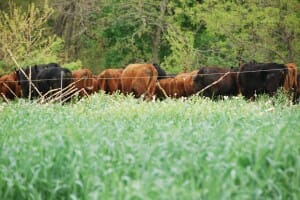Perennial Forage & Marketing Systems for Beef Cattle
An erratic spring and risk of thunder didn’t stop sixty people from attending Dan Specht’s field day on May 22. Organized by PFI, Iowa Learning Farms, and ISU Extension, the day featured grazier Dan Specht, University of Wisconsin agent Vance Haugen, farmer and marketer Eric Klien, and Audubon Society representative Justin Pepper.
The event started with a go-around where attendees named their favorite live and dead birds (some were bold enough to mention the Hawkeyes, and I won’t say in which category). Dan described his operation, which focuses on perennial forage cover with limited crop acreage. For years, he has grazed hairy vetch/winter rye cover crops, though this year it didn’t take too well. His Red Devon cows calve in the fall, and calves of late have been sired by a grass-based Red Devon bull. Calves spend their whole lives on grass, and rotated at least daily to fresh forage.
Some questions centered around the choice of forages, and to the use of cover crops. ISU Extension agent Denise Schwab pointed out that cover crops are important players in the emerging Iowa Nutrient Reduction Strategy – and that cattlemen can take advantage of that. Cover crops are not the only nutrient reduction method effective for both nitrogen and phosphorus, they are also useful for livestock feed. Putting more cover crops on fields is good for everyone. Similarly, the issue of crop insurance, the timing of cover crop termination, and grazing cover crops arose. Duane Voy, Regional Director for the Risk Management Authority in Minneapolis and St. Paul was kind enough to clarify the rules for 2013 – that grazing needed to be done by May 22, and cover crops terminated in another way (chemical or tillage) before cash crop planting. The rules for livestock use of cover crops prior to cash crop planting for 2014 have still not been decided. When in doubt, Duane reminded attendees to visit their crop insurance agents for the latest rules.
Other topics included marketing grass-fed beef. Eric Klien of Hidden Stream Farms described his marketing, which takes advantage of emerging food co-ops in highly-populated urban areas, such as the Twin Cities. Developing a standard of management and high quality product is essential to establishing a marketplace brand and useful for pooling product with other like-minded farms.

Jeff Segoe (NRCS) and Justin Pepper (Audubon Society) are among other participants at Dan Specht's field day
Justin Pepper from the Audubon Society also talked about a marketing strategy revolving around bird-friendly grazing, a practice Dan has been doing for years. While in the past grazing and habitat for ground-nesting birds were seen as mutually exclusive, Audubon has looked at research showing that in fact proper grazing is an essential part of a healthy habitat for many species, including quail. Different tiers of forage growth and maturity are needed for different life stages of the birds, so timely and considerate grazing provides them with areas to nest, forage, and feed. Audubon now hopes to test different grazing strategies in regions across the country, developing plans sufficient for different ecosystems and bird populations. In the future, this may lead to a certification system and premiums for bird-friendly beef.
Following the discussions and a trip to see the cattle and Dan’s innovative fence-building ideas, the group went back to the main farm for a lunch of Dan’s grass-finished beef, organic blue-corn tortilla chips, potato salad, baked beans, and cookies made from Iowa small grains.

